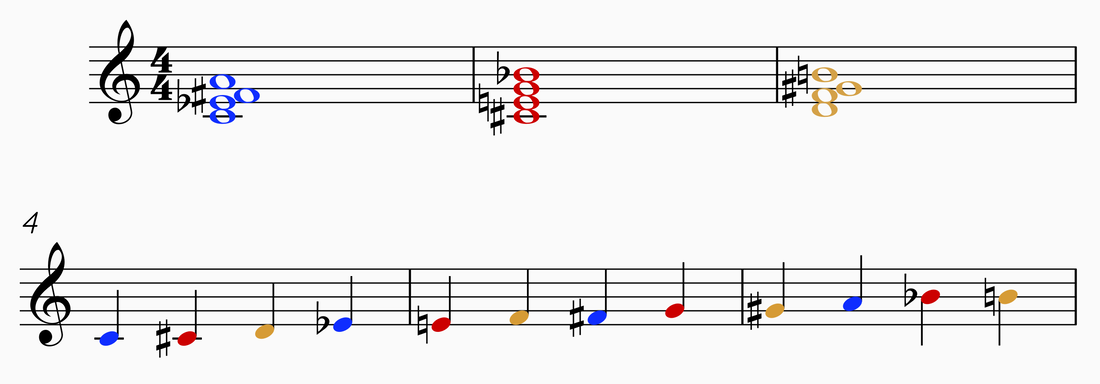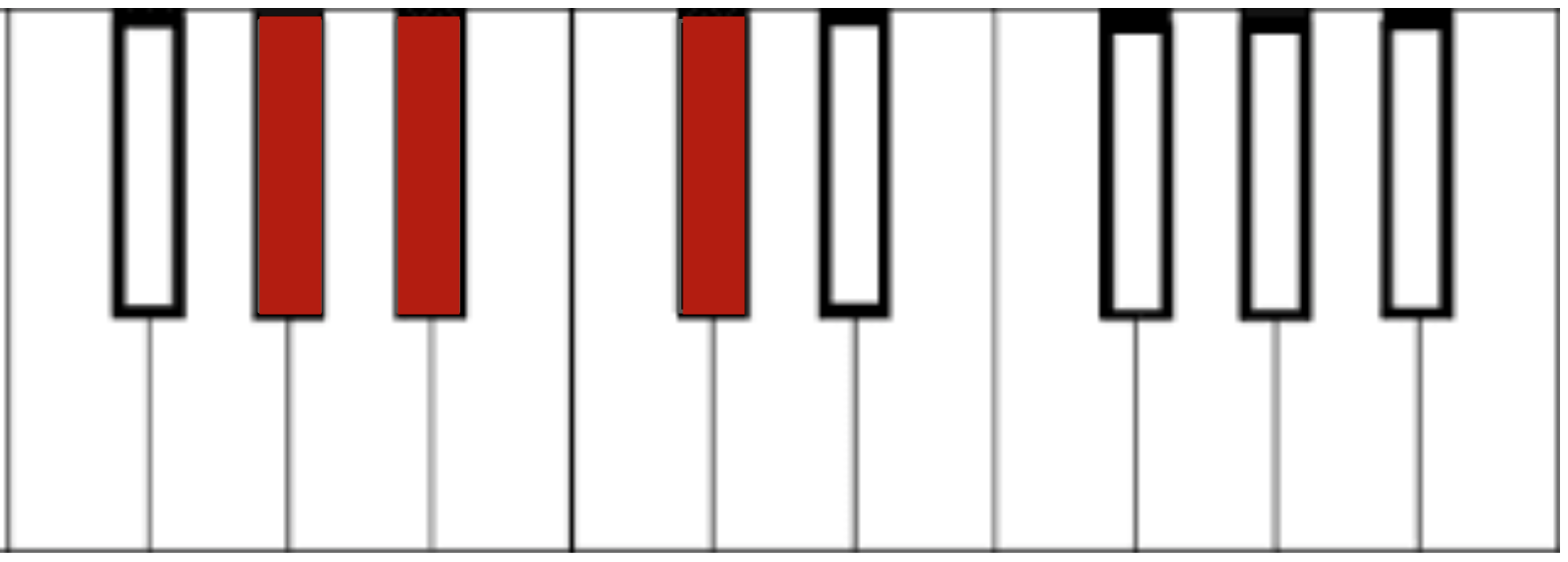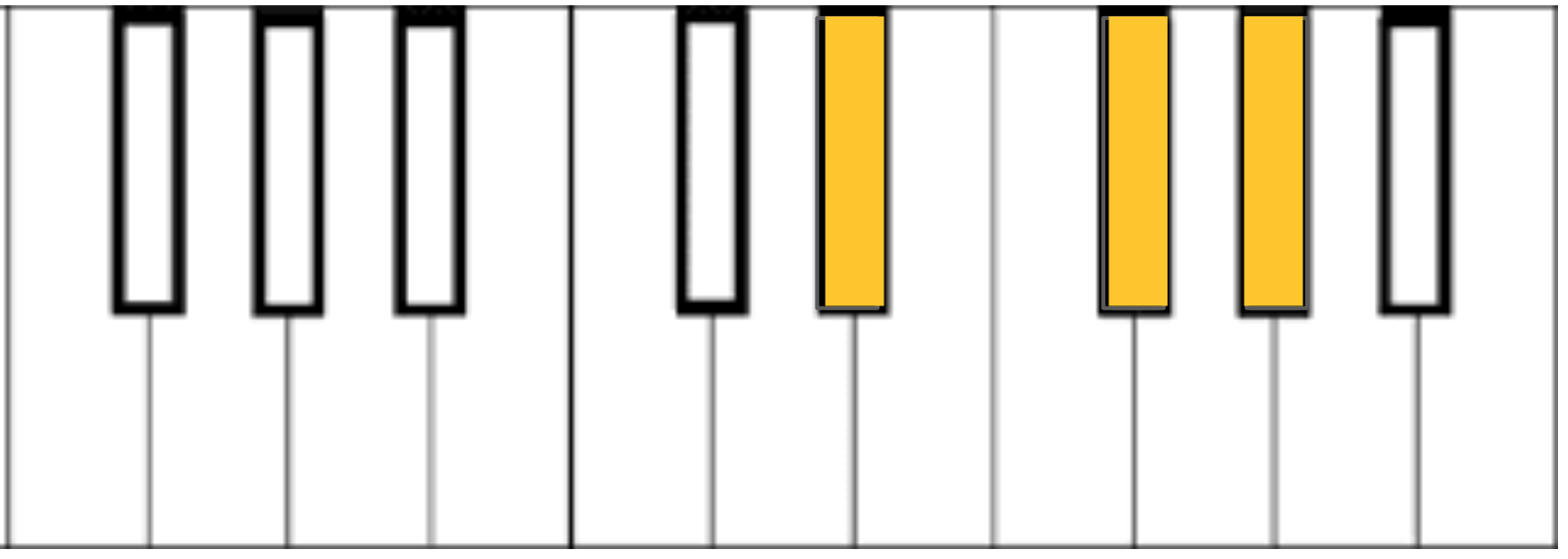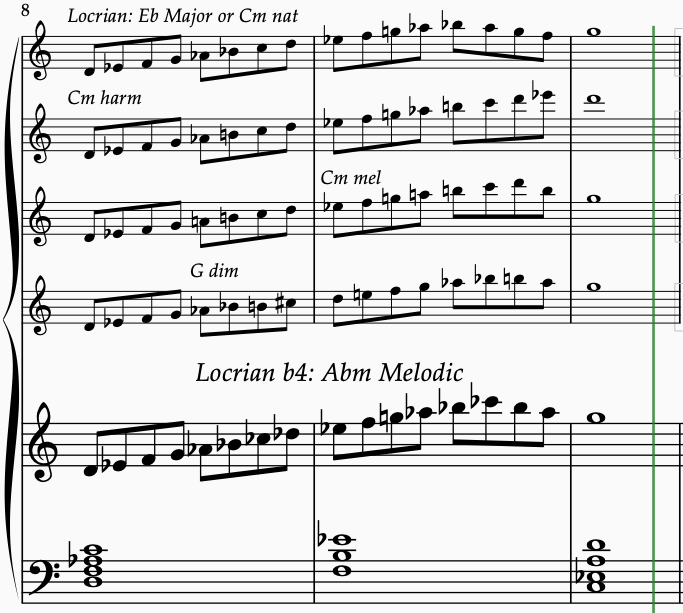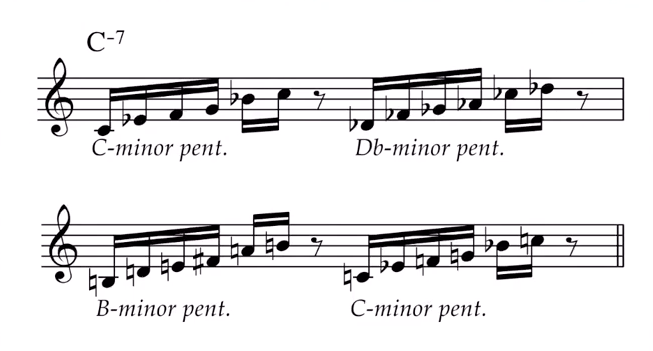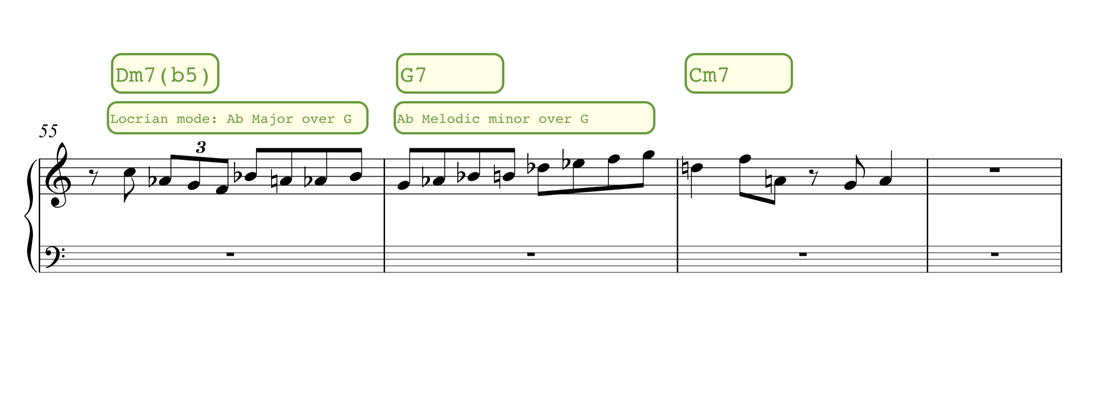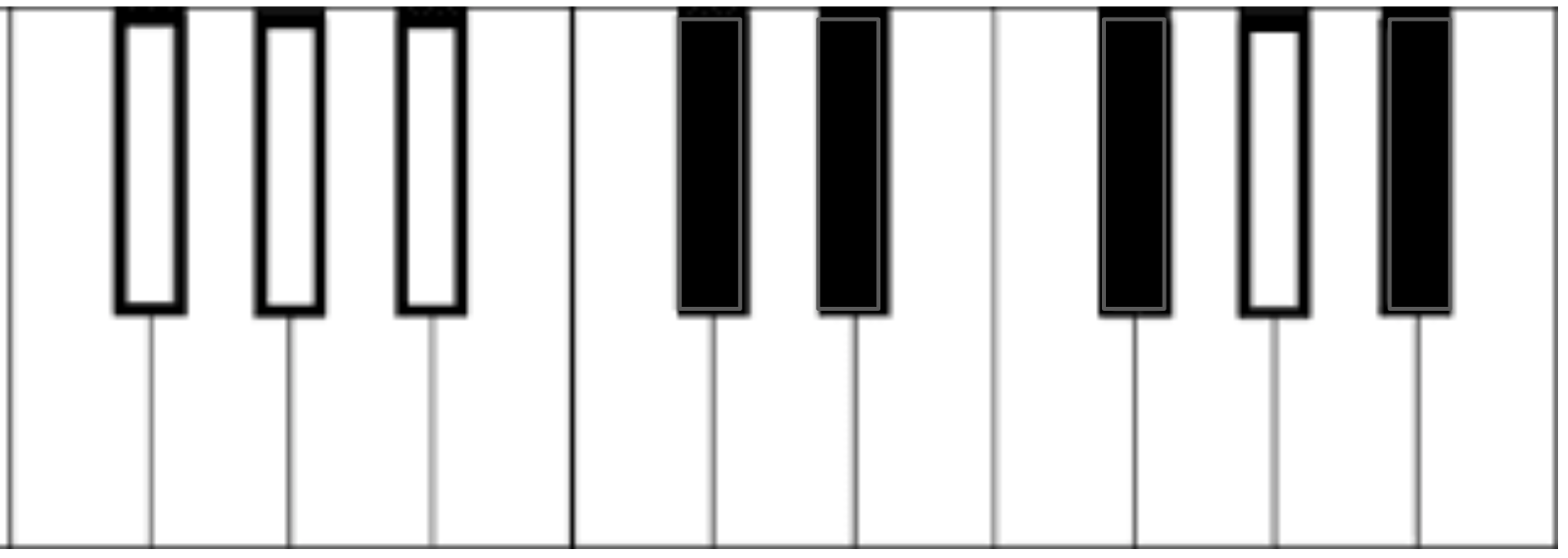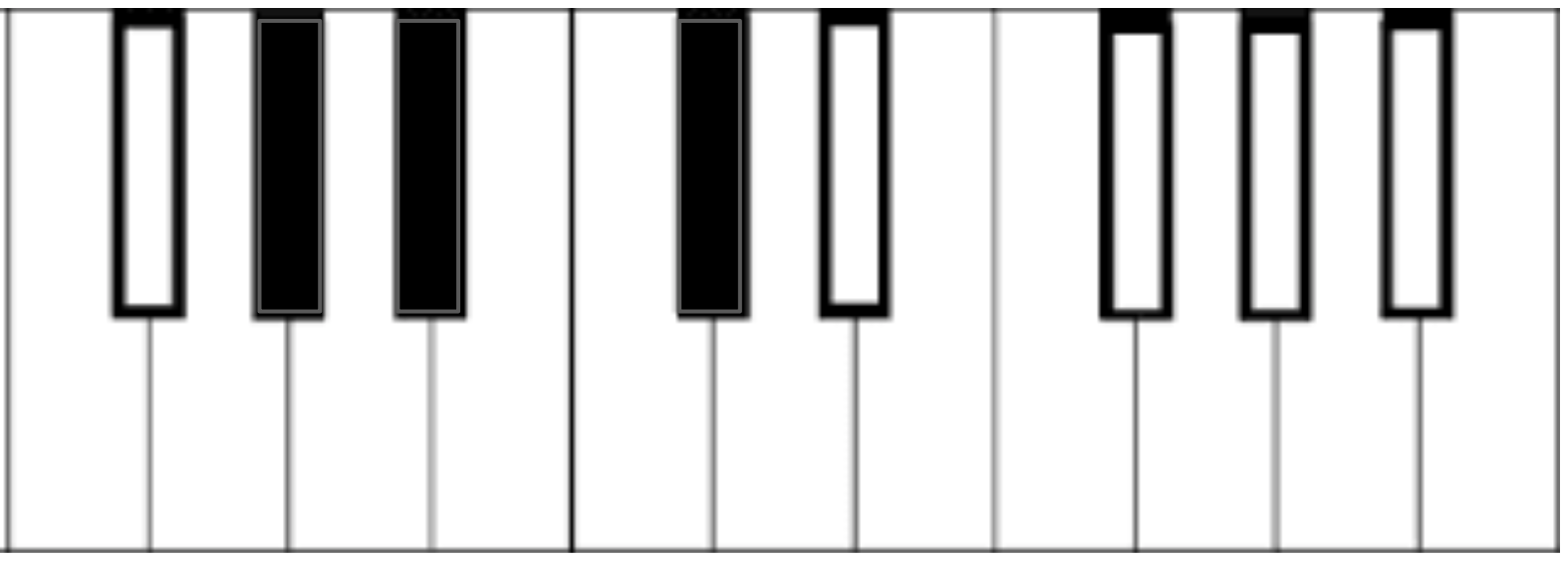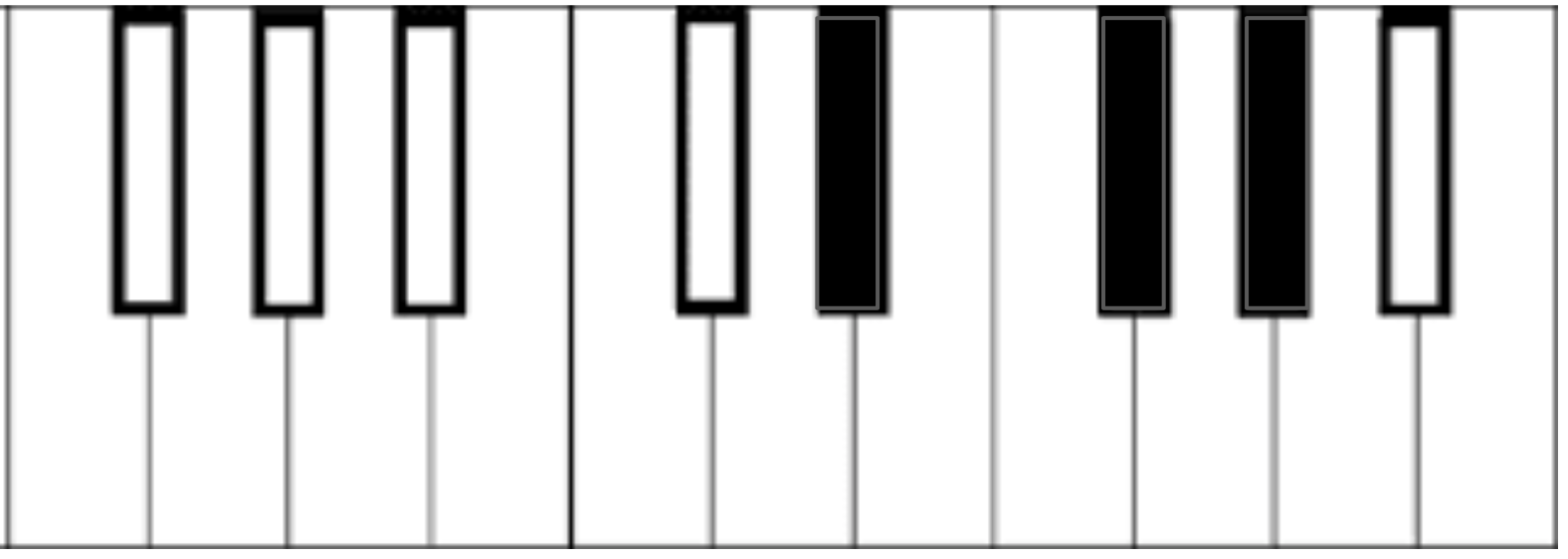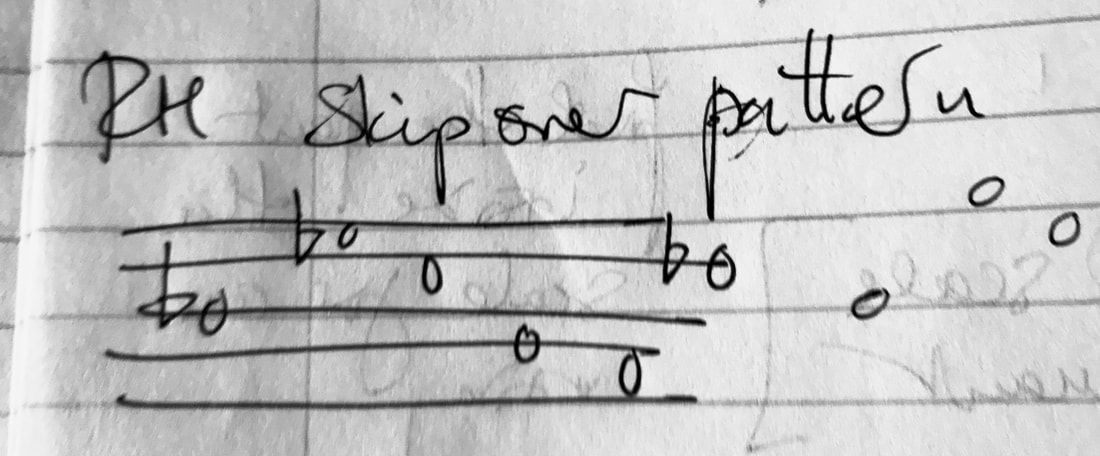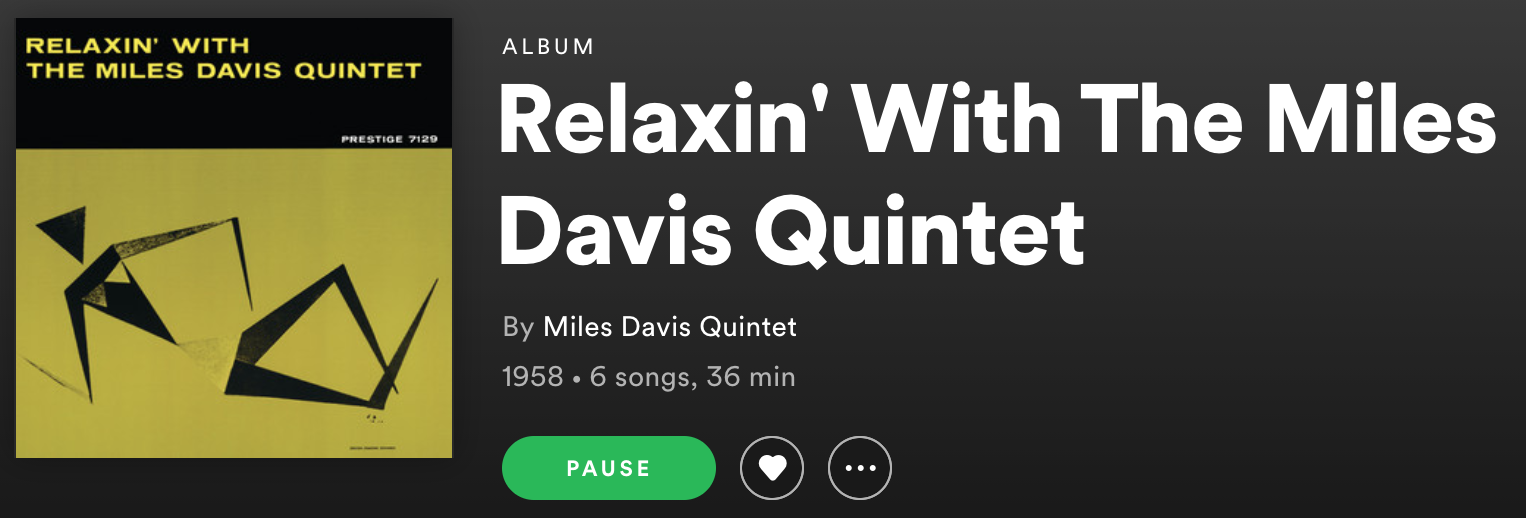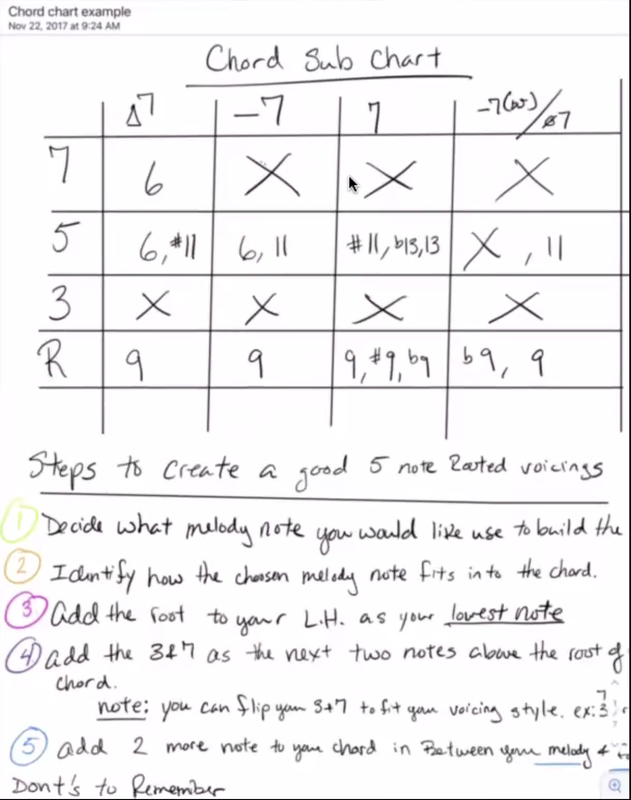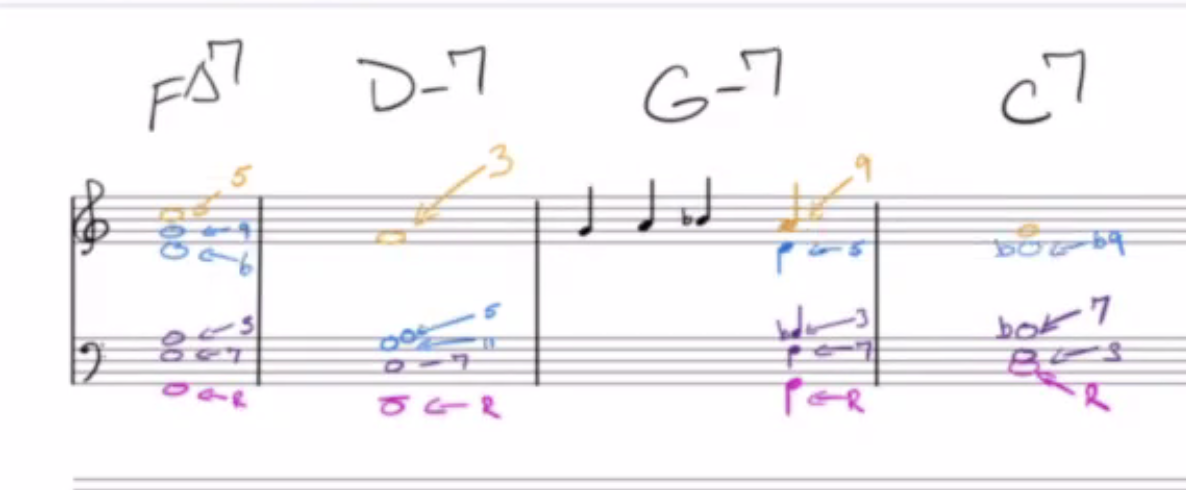BERNAL study page |
|
PRACTICE LOG
Access google practice chart here:
https://docs.google.com/spreadsheets/d/1pJ9tS2jR2rxEJHU4QZI45ZV3e1XALDOObtvk90wILZ8/edit#gid=1245708595
https://docs.google.com/spreadsheets/d/1pJ9tS2jR2rxEJHU4QZI45ZV3e1XALDOObtvk90wILZ8/edit#gid=1245708595
Diminished scales |
| ||
MINOR PENTATONICS
- Complete run 12k from the root
- UP-DOWN on the key of the root, the key of the 5th, the key 1-whole step UP (C - G - D)
- UP in one key, DOWN 1/2 step higher
- UP changing chords until reaches the top of the keyboard. DOWN the same way
MAJOR PENTATONICS
- Complete run 12k from the root
- UP-DOWN on the key of the root, the key of the 5th, the key 1-whole step UP (C - G - D)
2-5-1
Major 2-5-1
Combination -1- Example in C Major
RH plays the scale of the "I" through the 2-5-1 (C Major)
Combination -2- Example in C Major
IIm7 = mPent 5-UP
V7 (13) = dim scale of V
Im Maj7 = MPent 5-UP
RH plays the scale of the "I" through the 2-5-1 (C Major)
Combination -2- Example in C Major
IIm7 = mPent 5-UP
V7 (13) = dim scale of V
Im Maj7 = MPent 5-UP
Minor 2-5-1
Combination -1- Example in C Major
IIm7(b5) = natural minor of I (C natural minor) V7 (#5) (b13?) = harmonic minor of I (C harmonic minor) Im Maj7 = melodic minor of I (C melodic minor) OTHER COMBINATIONS TO TRY V7 = Locrian / EbM / Cm nat V7 = Cm harm V7 = Cm mel G dim / Locrian b4 / Abm mel Question for Paul:
Does this look right? Which other combinations are available with these chord progressions. Not too out there, because I prefer a gradual approach. |
2 - 5 - 1 General chart |
| ||
EXPERIMENT WITH THIS:
2 - 5 - 1 but in the V7, instead of LH = F - B - E, Try F - Bb - Eb and find out the improvisation that matches this unexpected turn for the V7
TRANSCRIPTIONS
JARRETT "Where Can I Go without You"Creating my own improvisation and complete setup of the song piano solo and piano with combo.
|
| ||||
MORE ON PENTATONICS
Exercises to move scale UP and DOWNBuilding pentatonics in C minor going up to C#m and down to Bm
GRB created exercises/drillsThese exercises happen during practice and then I forget about them. here are some of them:
Scale: switch to 1/2 UP, 1/2 BACK
Scale: switch 1/2 UP, 1/2 BACK, 1/2 DOWN, 1/2 BACK ARPEGGIOS in 4ths UP and Down mimicking the LH position Broken arpeggios skipping middle notes. |
Broken scales fingering
| ||||||||||||||||
Peter Martin transcriptionTranscription of Peter Martin demonstrating pentatonic improv. "Dive into Pentatonics".
|
| ||||||
EXERCISES IN 2 - 5 - 1 Major and Minor by Jimin Park
2-5-1 in Major key
| |||||||||||||||||||||||
60' |
2/11
F - D - C |
|
Done
| ||
|
Done
| ||
|
Done
| ||
| |||
2-5-1 in Minor key
2 - Locrian
5 - Melodic minor 1/2 UP or Diminished
1 - Minor with raised 6+7 or Harmonic minor
60' |
2/11
C - |
| jimin_2-5-1_in_cminor.pdf |
Exercising the V7 diminished scale
Reference: b9th
Every note can belong to two dim scales, and by elimination it doesn't belong to one of them.
One of the dim is H-W, the other is W-H
Every note can belong to two dim scales, and by elimination it doesn't belong to one of them.
One of the dim is H-W, the other is W-H
MY ONE AND ONLY LOVE. C Major. Harmonization
|
| ||||
11/20
Harmonization of the main theme |
|
TUTORIAL BASED LESSONS.
|
SCALES.
Write down the scales that are being use in these exercises and crate a full chart. We are going to use as reference a jazz pianist/teacher that has a well organized channel on Youtube. First lesson, basic, will be on practicing scales based on a 2 - 5 - 1 chord progression just to get your ear used to these dissonances. After you are able to play it in the original key we will start transposing it to other keys.
Magyel "ALL OF ME" Exercises
|
| ||||||||||
|
Learned in C, D, E.
Analyzed in E. Next is to transfer all the analytics to the exercise in C and D Then create a blank sheet containing only the analytical cues to create an improvisation based on the suggested scales. Create score that has only the indications but not the notes and following the indications you have to create the improvisation. |
| ||||||||||||
NEXT RECORDING: Blame It on My Youth (Keith Jarrett version) |
| ||
Lessons with Paul Bratcher
|
6/16
The exercises I am creating: Don't get too complicated, rather than difficult exercises, work on smaller groupings of 4 notes. Groupings in clusters and playing the notes all at the same time. Assimilate the unit. Finding the triads in the scale C7 -> C# (the b9) and play C#Major triad notes (PLUS ONE). Add an extra note that matches (belongs to) the chord on the LH Then exercise with these patterns. Moving scale exercises up and down 1/2 step: Use smaller patterns, that is more applicable in improvisation No need to use long scales. Ok to practice them, but not as applicable. USING PENTATONIC SCALES IN DIFFERENT CONTEXTS C minor pentatonic can be used in the following contexts: Cm --> LH Pent chords C# --> LH Pent chords D --> Altered (#9) chords Eb --> EbMaj7 and Eb7 Pent chords E --> Difficult sound. Heavy altered F --> As F7 and F Pent F# G --> G7 Altered // G(#9) // Maybe Pent G# --> Maj7 // Pent A --> Altered #9 Bb B --> B7 not Pent 5/26
8th, 16th notes as foundation. Add triplets Scale played in broken 3rds as 8th, 16th, and triplets Take the same scales I am practicing and convert the meter to triplets LH Dorian is OK Build comp shapes using LH-RH C Dorian scale has inside 3 pentatonic: C minor pent G minor pent D minor pent and of course, the relative major pentatonics also. For GRIT: use the 6th instead of the 7 (Coltrane sound) C minor: use the other pentatonics for other sounds Cm be the center. 5th (Gm) different character. Softness 9TH (Dm) Is very out there in sound PETER MARTIN He uses imposing harmonies Using LH dominant vs minor Cm, pentatonic on LH, one of the chords is the F7 (Eb-A-D). This chord is a dominant that launches other possibilities: LH F7 --> RH F#m pent (b9, 3, #9, b13) LH F7 --> RH G#m pent Using pentatonics off a dominant chord: Alter dominant (AKA Diminished whole-tone) It is a "melodic minor played 1/2 step above" F7 in a 2-5-1 Use the altered dominant on the V7 Then find the pentatonic inside the scale you are using. EXTRACTING PENTATONICS FROM THE SCALE WE ARE USING Build a pentatonic starting on each note of the scale and see how many can bou build. Do this same exercise also with the Altered Dominant LH Use a Dominant because of the colors available #9, b9, #5, b5, etc. Thinking and improvising in F7 while bass is still playing Cm RH SKIP OVER PATTERNS Patterns must be in fingers in every key
Wider intervals, angular sound Bass Cm. LH F7 --> RH 1/2 step above dominant = F# pentatonic 5/5
Davinci/resolve versus Final Cut-Pro or iMovie ManyCam little quirks Share the Jesu Joy arrangement Improvising on a modal. Video of kayak sailing Use pentatonic minor Pentatonic on the 2nd degree of Cminor (D For Fm7, same sound Bb7 dim wholetome For G7 #9, melodic minor 1/2 step up from the V7, which gives you a diminished whole tome. PETER MARTIN on Pentatonicxs will be a good source to learn this When playing on pentatonic, move far away, the farthest is a tritone UP. From Cm to F#m McCoy also uses chord progressions whole step apart from each other. mirroring them with the RH scales. Paul sounded amazing doing all that. 4/7
Mentioned: Students like Jonathan Orloff. Biff Smith arrangements and harmonizations Notebook log for practice Shehan Rajapakse and Paul's student Milo attend the same high school and both are pianists at the same Jazz Band. PAUL: Paul Carr tenor player: Hear diatonically. Exercises 5' - 10' Use the iRealPro exercises on 2-5-1 in every key and play the scales 1- starting on the note 2- starting on different notes Keep it melodic, stay diatonic Blues as a simple enough structure to apply scales as well GRB: YT ADDRESSED TO TEACHERS RATHER THAN TO STUDENTS? IEJE CONFERENCE JAZZ EDUCATION NETWORK Speakers, conferences Levine grant may cover some of the costs BPC!!! Gary Prince did not like the conferences. Paul and Gary don't coincide in pedagogical visions. Brad goes to them regularly Buy the YT material to learn the sequencing of the teaching method and delivery of information OPEN STUDIO Peter Martin and Adam Mannes Peter is the intuitive explainer Adam is the structural explainer SUSCRIBE TO THEIR PAID MATERIAL. 1st week free. Worth it. Noah -???- last name? Very well explained material GRB: VOICINGS. THE USE OF BIFF SMITH to open ears Paul goes more methodically Apply voicing and open harmonies to COMPING Chords first as 3-note chords like 3-7-9 and 7-3-5 Then 4-note chords as 3-7-9-(5 RH) and 7-3-5-(7 RH) All colors produced while comping BRATCHER CHART (See side notes) 3/17 My teaching started mostly focused on reading from Real book for classical pianists Teaching the beginnings of improvisation. Some students are starting to get it. Going back to the root. Putting myself in the shoes of the beginner student and going page by page through the book. Practicing myself what I will be teaching from the very beginning in all 12-keys. GRB: Fingering for Dominant-Bebop scale. Traditional fingering doesn’t fit Book uses a 2-1-2-1 3-2-1 3-2-1 PB: Placement of the thumb over anything else. Strengthen 1-2-3 fingering. Pivoting. Bebop scales / diminished scales / altered scales are mostly played with 1-2-3. GRB: Complex classical fingering get in the way of improvisation bc it imposes the will of the hand rather than the will of the mind. Simple fingering seems is simplify the process of transfer from your mind to the keyboard. PB doesn't have a specificities opinion on using what I call all-terrain 4 wheel drive fingering. He doesn't use that system. GRB: I am able to “hear” in my head a complete improvised solo over a chord progression. Especially after listening to recordings for a number of minutes. I can even visualize the keyboard and see my hands playing the notes slowly, so that I can almost name the notes slowly. Then when I actually try to play it, my mind stalls and the fingers want to play what they are comfortable. We exercised at the lesson singing and transferring the idea from the mind to the keys. Singing and playing the side vs your fingers having an idea and then singing it, which is the reverse process, and not ideal. GRB: At the lesson I noticed that if I looked away from the keys, my mind would be ahead of the game. If I looked at the keys, my fingers found patterns and dictated what to play. GRB: How to exercise with the students to liberate them from being stock on an idea, or stock on a small range of notes at the piano. PB: Ask them to play more "scale-ly". More "set-wise" at first. Use BACK-AND-FORTH teacher-student so they hear you play and they get inspiration from your playing. Place yourself in the level of the student, not playing out with complex lines. 1- Consecutive tones when improvising. 2- Move to thirds after first step is ok. Start with a 2-5-1, then trade fours, etc. GRB: We looked at my composed improvisation on “On Green Dolphin Street” PB: Improvise on the same tune and let's hear the difference. I could barely keep up remembering the chords. GRB: Identifying a mystery scale on a 2-5-1 in F Happens to be diminished whole-tone, mixed with melodic minor of the tonic. This is a sound common on Herbie Hancock from the 60s when he played with Miles Davis: Nefertiti, Sorcerer Creating chords directly from the scales. Practice going up each degree fo the melodic minor scale and see what tones are forming. Mulgrew Miller forms chords using the tones of the scale, rather than chord tones. 3/10
TEACHING ENCLOSURES: Chromatic motion: building muscle memory and speed Degrees of the chord: building awareness and understanding Written exercise versus mental concept:give them the model and they can turn it into an exercise. No need to write everything down. DIMINISHED SCALES They can be too advanced for some students. Teach them related to V7 chords always Gradual teaching: 1- Mixolydian 2- Introduce the 9th, the b9th and the #9th. GRB: Learn the Diminished Whole-Tone Great resource for V7 in tunes like: Caravan, Take the A Train. Starts as dim, continues as whole-tone. USING METHOD BOOKS FOR TEACHING He is thinking of creating a method similar to Suzuki but for jazz, for young children. - Jazz Piano Comping. Jim Snidero For students with bad reading skills, to learn rhythms. School big bands. Based on standards but not the actual songs (© issue). - 15 Easy Jazz Etudes. Bob Mitzer For students whose ears/reading is not yet great. "Amazing Phrasing". Debbie Denke This book helped Paul himself. Similar to Aebersold, loops not too long STUDENTS MUST GET iRealPro AND BLUETOOTH SPEAKER Use the app through a separate device fro Zooming, not the same. PREP TIME. RECYCLING MATERIAL; Paul uses a share folder in which he places material such as - Learn voicing 2-note voicing, 3-note voicings, TECH AND RESOURCES Paul takes a tune from iRealPro Records a solo on top of it using Garage Band Sends to the student for student to practice comping chords over Paul's solo. 3/3 LICKS: Full blown licks are too much and have too many elements to digest. Start by isolating a single element from the lick. "Enclosure" and play it in every key. Use it in different environments. - Enclosure of the 1, of the 3, of the 7, etc. - Goal of playing them in all 12 keys chromatically Then practice how to get IN and OUT of the enclosure. Use back-forth teacher-student demonstration so student can hear and feel inspired by hearing the teacher. Start practicing with the student 3 or 4 keys at a time. Eventually cover all 12 keys. Keep units very small. TRANSCRIPTIONS: Notes versus feel. Red Garland, Miles Davis. Relaxin' Solos are short, the pianist is a sideman rather than a big part of a trio Simpler solos for ears that still need development: Herbie Hancock -Watermelon Man Horace Silver -More of a motive approach Thelonius Monk -Low chops but dissonant. "Bag's Groove' record. APP FOR TRANSCRIPTION: Transcribe! About $30 or $40 Allows to tune the app to your own piano Guesses notes for you Can divide the transcription into sections. How many measure per week if the transcription takes 3 months? SCALES: Practice them with rhythm exercises Use words. Paul's words are "Meatloaf", "Barbecue", "Barbecue sauce", "Tommy Flanagan". CAMERA SETTING: "MANY CAM" APP for splitting and many other functions. https://manycam.com |
Practicing after 3/3 lesson3/8
Isolate technical element and practice in every key
3/10
New variation on the exercise for enclosures. Focus on each note of the chord in which we are. C7: C- E - G - Bb - C and create an enclosure for each one. Then... Cm7 C - Eb - G - Bb - C and do the same. Do this for each variation of the enclosure.
| ||||||||||
